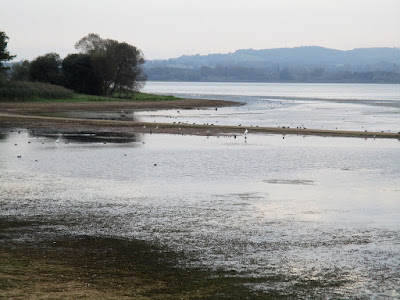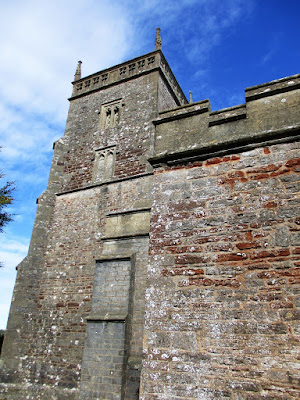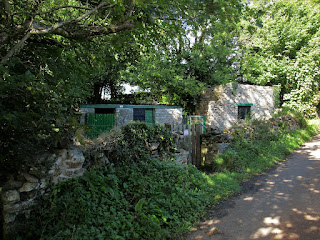Number of trees whose branches sound like harps played by the wind? Or whose wood is sought after to make dulcimers for fairies?
None. Harptree comes from the Old English herepoep and treow, meaning 'the military road by the wood'.
Number of stone stiles on our route?
Four.
Number of former cockpits now masquerading as an enclosure for a wooden house?
One. (The field itself used to be known as cockpits, apparently.)
Number of swallows snaffling the last of the finger buffet before heading off to South Africa.
Loads.
Number of swallows to be seen when two buzzards pitched up?
None. There were a few very flustered pigeons, however.
Number of very scraggy-looking, perimoulting robins?
One.
Number of words I've just made up there?
Also one.
Number of noticeable depressions in the middle of fields?
Many. This naturally-occurring sinkhole in the limestone ...
... and me every time I realised there was yet another steep, tussocky hill to climb.
Number of overly nosy heifers?
Didn't stop to count but the thundering of hooves coming up behind us suggested many.
Number of bulls, albeit young and scrawny and with as yet rubbish horns?
Isn't one enough?
Number of curious and/or affable horses just wanting to make friends?
Five. And one very un-affable, unfriendly dog.
Number of Grade II-listed, 70 foot lead smelting chimneys?
Four.
Ha, trick photo! There's only one left in the whole of the West Country.
Number of yellow stagshorn fungi?
Not sure how you count it.
Number of elderberries?
Oh don't be silly.
Number of iron lions?
One.
Number of views on this walk?
One, of Chew Valley Lake.
Number of photos of the one view on the walk?
More than this collage will hold. Clearly, I have a memory worse than a goldfish's. Ooh, that's a nice view ... ooh, that's a nice view ... ooh, etc.
Number of Old Mrs Edwardses, a noted laundress, standing white-aproned and white-haired outside her cottage with honeysuckle over the door and two skip beehives among the flowers on either side, looking up at the sweep of Mendip before her and so completing an unforgettable picture?
None.
Number of wet, smelly, happy border collies?
Just Ted.
 It's National Poetry Day today and the theme is Freedom. So here's a poem on that subject from my collection Breadcrumbs, which is published by Indigo Dreams.
It's National Poetry Day today and the theme is Freedom. So here's a poem on that subject from my collection Breadcrumbs, which is published by Indigo Dreams. 























































